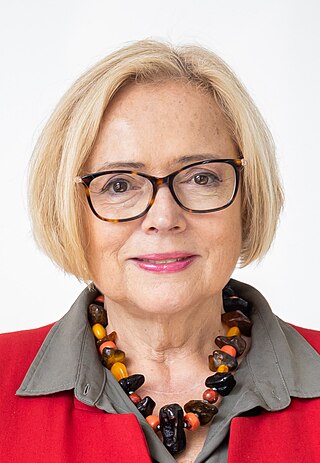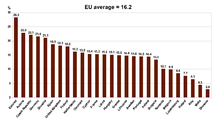
Maria Wisława Anna Szymborska was a Polish poet, essayist, translator, and recipient of the 1996 Nobel Prize in Literature. Born in Prowent, she resided in Kraków until the end of her life. In Poland, Szymborska's books have reached sales rivaling prominent prose authors', though she wrote in a poem, "Some Like Poetry", that "perhaps" two in a thousand people like poetry.

Polish literature is the literary tradition of Poland. Most Polish literature has been written in the Polish language, though other languages used in Poland over the centuries have also contributed to Polish literary traditions, including Latin, Yiddish, Lithuanian, Russian, German and Esperanto. According to Czesław Miłosz, for centuries Polish literature focused more on drama and poetic self-expression than on fiction. The reasons were manifold but mostly rested on the historical circumstances of the nation. Polish writers typically have had a more profound range of choices to motivate them to write, including past cataclysms of extraordinary violence that swept Poland, but also, Poland's collective incongruities demanding an adequate reaction from the writing communities of any given period.
The Old Left is an informal umbrella term used to describe the various left-wing political movements in the Western world prior to the 1960s. Many of these movements were Marxist movements that often took a more vanguardist approach to social justice; focused primarily on labor unionization and social class in the West. Generally, the Old Left, unlike the New, focused more on economic issues than cultural ones.
The history of feminism comprises the narratives of the movements and ideologies which have aimed at equal rights for women. While feminists around the world have differed in causes, goals, and intentions depending on time, culture, and country, most Western feminist historians assert that all movements that work to obtain women's rights should be considered feminist movements, even when they did not apply the term to themselves. Some other historians limit the term "feminist" to the modern feminist movement and its progeny, and use the label "protofeminist" to describe earlier movements.

The League of Polish Families is a social conservative political party in Poland, with many far-right elements in the past. The party's original ideology was that of the National Democracy movement which was headed by Roman Dmowski, however, in 2006 its leader Roman Giertych distanced himself from that heritage.
Socialist feminism rose in the 1960s and 1970s as an offshoot of the feminist movement and New Left that focuses upon the interconnectivity of the patriarchy and capitalism. However, the ways in which women's private, domestic, and public roles in society has been conceptualized, or thought about, can be traced back to Mary Wollstonecraft's A Vindication of the Rights of Woman (1792) and William Thompson's utopian socialist work in the 1800s. Ideas about overcoming the patriarchy by coming together in female groups to talk about personal problems stem from Carol Hanisch. This was done in an essay in 1969 which later coined the term 'the personal is political.' This was also the time that second wave feminism started to surface which is really when socialist feminism kicked off. Socialist feminists argue that liberation can only be achieved by working to end both the economic and cultural sources of women's oppression.
Antifeminism, also spelled anti-feminism, is opposition to feminism. In the late 19th century and early 20th century, antifeminists opposed particular policy proposals for women's rights, such as the right to vote, educational opportunities, property rights, and access to birth control. In the mid and late 20th century, antifeminists often opposed the abortion-rights movement.

Kultura —sometimes referred to as Kultura Paryska —was a leading Polish-émigré literary-political magazine, published from 1947 to 2000 by Instytut Literacki, initially in Rome and then in Paris. It was edited and produced by Jerzy Giedroyc and ceased publication upon his death.
In one scholarly conception, the history of feminism in Poland can be divided into seven periods, beginning with 19th-century first-wave feminism. The first four early periods coincided with the foreign partitions of Poland, which resulted in an eclipse of a sovereign Poland for 123 years.

The roles of women in Hungary have changed significantly over the past 200 years. Historically, in the present day territory of Hungary, discourses on women’s roles, rights, and political access, along with feminist movements, have developed within the context of extremely traditional gender roles that were influenced by Roman Catholicism, Lutheranism and Calvinism. More recently, the Communist doctrine on women’s place in society was also influential. The post-communist era in Hungary has produced a number of organizations to address the needs of the nation’s women and mobilize female voters, and several universities now have gender studies programs. In the 21st century, the entry in the European Union has led to a more 'Westernized' culture.
Human rights in Poland are enumerated in the second chapter of its Constitution, ratified in 1997. Poland is a party to several international agreements relevant to human rights, including the European Convention on Human Rights, the Universal Declaration of Human Rights, the Helsinki Accords, the International Covenant on Civil and Political Rights, the International Covenant on Economic, Social and Cultural Rights and the Convention on the Rights of the Child.
Shortly after feminist ideology started gaining popularity in the mid-19th and early 20th century in the United Kingdom of Great Britain and Ireland and the United States, and slowly the rest of the world, the movement begun affecting changes to the social and political life of Greece. In 1952, Greek women gained the right to vote. However, other changes did not come until a few decades later, as with, for example, the introduction of sweeping changes in family law in 1983. Greece signed the Convention on the Elimination of All Forms of Discrimination against Women and ratified it in 1983.

The Czech Republic provides a wide variety of civil rights to female citizens and Czech women have a long history of actively participating in Czech society. However, women in the Czech Republic continue to experience gender discrimination, particularly in the workforce and political arena.

The first women's association in Albania was founded in 1909. Albanian women from the northern Gheg region resided within a conservative and patriarchal society. In such a traditional society, the women had subordinate roles in Gheg communities that believe in "male predominance". This is despite the arrival of democracy and the adoption of a free market economy in Albania, after the period under the communist Party of Labour. Traditional Gheg Albanian culture was based on the 500-year-old Kanun of Lekë Dukagjini, a traditional Gheg code of conduct, where the main role of women was to take care of the children and to take care of the home.

Wanda Hanna Nowicka is a Polish activist and politician, Member of Parliament of Poland during 7th (2011–2015) and 9th terms (2019–2023). She served as the Deputy Marshal of the Sejm of the Republic of Poland from 8 November 2011 to 11 November 2015.

Changes in gender roles in Central and Eastern Europe after the fall of Communism have been an object of historical and sociological study.

The Left is a political alliance in Poland. Initially founded to contest the 2019 parliamentary election, the alliance now consists of the New Left and Left Together.

The anti-gender movement is an international movement that opposes what it refers to as "gender ideology", "gender theory" or "genderism", terms which cover a variety of issues and do not have a coherent definition. Members of the anti-gender movement primarily include those of the right-wing and far-right political spectrum, such as right-wing populists, social conservatives, and Christian fundamentalists. It has been linked to a shift away from liberal democracy and towards right-wing populism. Anti-gender rhetoric has seen increasing circulation in trans-exclusionary radical feminist (TERF) discourse since 2016. Different members of the anti-gender movement variously oppose some LGBT rights, some reproductive rights, government gender policies, gender equality, gender mainstreaming, and gender studies academic departments. The Canadian Security Intelligence Service has linked the anti-gender movement to the risk of "extreme violence" against the LGBT+ community.
Liberalism has been a notable ideology in Poland for hundreds of years. Polish liberalism emphasizes the preservation of democracy and opposition to authoritarianism. Liberalism was first developed in Poland as a response to the Polish–Lithuanian monarchy, and it continued to develop in response to the partition of Poland through the 19th century and Communist rule in the 20th century. Poland has officially been a liberal democracy since 1989, though its status has challenged as a result of illiberal reforms in the 2010s and 2020s.

The 1996 Nobel Prize in Literature was awarded to the Polish poet Wisława Szymborska (1923–2012) "for poetry that with ironic precision allows the historical and biological context to come to light in fragments of human reality." Szymborska is the 9th female recipient and the 5th Nobel laureate from Poland after Czesław Miłosz in 1980.



































